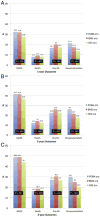Temporal trends in percutaneous coronary intervention outcomes among older patients in the United States
- PMID: 23895810
- PMCID: PMC4406473
- DOI: 10.1016/j.ahj.2013.05.006
Temporal trends in percutaneous coronary intervention outcomes among older patients in the United States
Abstract
Background: New percutaneous coronary intervention (PCI) device technologies are often rapidly adopted into clinical practice, yet few studies have examined the overall impact of these new technologies on patient outcomes in community practice.
Methods: In hopes of determining temporal trends in PCI outcomes, we used data from the Centers for Medicare & Medicaid Service's Chronic Condition Warehouse (n = 3,250,836) by comparing patient characteristics and rates of 3-year major adverse cardiac events (MACE) across the balloon angioplasty (POBA) era (01/1991-09/1995), the bare metal stent (BMS) era (02/1998-04/2003), and the drug-eluting stent (DES) era (05/2004-10/2006). The adjusted association between era and outcomes was determined with Cox proportional hazards modeling (POBA era as reference).
Results: Compared with the POBA era, patients undergoing PCI were significantly older and had more medical comorbidities, and the risk for 3-year MACE was significantly lower during the BMS and DES eras (BMS vs. POBA adjusted HR [95% CI]: 0.930 [0.926-0.935]; DES vs. BMS: 0.831 [0.827-0.835]). Compared with males, the adjusted risk for 3-year MACE among females was lower during the POBA era, but slightly higher during the BMS and DES eras. Across all three eras, patients ≥75 years of age had higher adjusted risk for MACE compared with younger patients, and the risk for revascularization was lower for both females and older patients.
Conclusions: Despite its application in older and sicker Medicare beneficiaries, there has been a significant decrease in post-PCI MACE over time. The risk for death or myocardial infarction is higher among females and older patients compared with males and younger patients; therefore, future studies should focus on improving clinical outcomes in these high-risk subgroups.
Copyright © 2013 Mosby, Inc. All rights reserved.
Conflict of interest statement
Conflict of Interest Disclosures: SV Rao: Dr Rao reports research funding: Cordis Corporation; Consultant/Honoraria: The Medicines Company, Zoll, Terumo Medical, Astra Zeneca, Daiichi Sankyo Lilly, Bristol Myers Squibb, Sanofi-Aventis.
CN Hess: Dr Hess has no disclosures to report.
D Dai: Dr Dai has no disclosures to report.
CL Green: Dr Green has no disclosures to report.
ED Peterson: Please see
PS Douglas: Dr Douglas has no disclosures to report.
Figures



References
-
- Stone GW, Ellis SG, Cox DA, et al. A polymer-based, paclitaxel-eluting stent in patients with coronary artery disease. N Engl J Med. 2004;350:221–31. - PubMed
-
- Stone GW, Rizvi A, Newman W, et al. Everolimus-eluting versus paclitaxel-eluting stents in coronary artery disease. N Engl J Med. 2010;362:1663–74. - PubMed
-
- Moses JW, Leon MB, Popma JJ, et al. Sirolimus-eluting stents versus standard stents in patients with stenosis in a native coronary artery. N Engl J Med. 2003;349:1315–23. - PubMed
-
- Rao SV, Shaw RE, Brindis RG, et al. Patterns and outcomes of drug-eluting coronary stent use in clinical practice. Am Heart J. 2006;152:321–6. - PubMed
-
- Singh M, Rihal CS, Gersh BJ, et al. Twenty-five-year trends in in-hospital and long-term outcome after percutaneous coronary intervention: a single-institution experience. Circulation. 2007;115:2835–41. - PubMed
Publication types
MeSH terms
Grants and funding
LinkOut - more resources
Full Text Sources
Other Literature Sources
Medical
Miscellaneous

